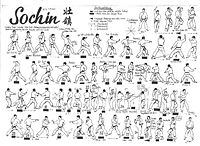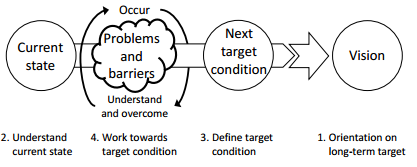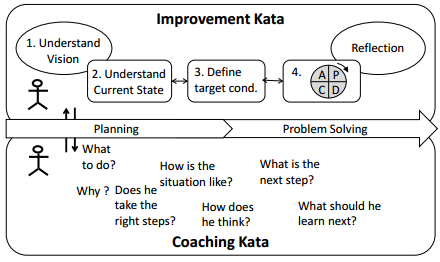The Kaizen – Toyota KATA method
(→How does it work – processes and tools) |
|||
| Line 36: | Line 36: | ||
#:In short, at this state one needs to collect data and facts about the current state, define process and output metrics | #:In short, at this state one needs to collect data and facts about the current state, define process and output metrics | ||
# Define target condition | # Define target condition | ||
| + | #: While the vision of is the long term goal, far in the future, the target condition is a description of the success 1-3 years in the future <ref>[''http://www-personal.umich.edu/~mrother/Handbook/Full_IK_Handbook_v32.0.pdf''] ''Improvement Kata Handbook by Mike Rother - a practivcal guide in 552 powepoint slides''</ref> | ||
# Work toward target condition | # Work toward target condition | ||
#: PDCA and the PDCA cycle record template | #: PDCA and the PDCA cycle record template | ||
Revision as of 11:09, 21 September 2016
Overall there are two paradigms within management – the Command and Control Paradigm (CCP) and the Interaction and Learning Paradigm (ILP) [1]. The first one, CCP, would put the manager in the position of an enlightened leader, who has all the answers and operates in a deterministic world. In other words, the manager like the conductor of an orchestra, directs the symphony, giving specific directions to each musician. On the other side, we find the paradigm of interaction and learning, where a manger does not yet have all the answers, but acquires them through interaction. A manager rather than giving detailed action plans, creates a frame for action. It is said that the second approach works better when dealing with complex tasks, varying demands, and unpredictable environments. Within project management these two paradigms are also represented in the form of traditional and agile project management. This article views project management from the ILP paradigm and it assumes that a project or a portfolio manager often needs to deal with problems without having a clear solution. In this situation the right approach always has to do with exploration and innovation.
This article examines a management method, which has proven to be very successful in supporting fast and innovative solutions to complex problems in Toyota, namely Kaizen and the Toyota Kata method. This article states that project and portfolio managers dealing with product or process development and organisational change can benefit from the teachings of Kaizen and Toyota Kata.
The Kaizen method engages manager and employees to think solutions beyond the usual, and ensures continuous improvement, as it breaks the problem at hand into smaller problems, solved one by one using the scientific method[2] of experimentation instead of the usual "implementation" approach. This liberates the solutions as the improvement efforts are allowed to lead to failure and failure is even a welcomed learning. The efforts themselves are encouraged to be small, so that their effect can be controlled and, most importantly, confirmed. An important benefit of the Kaizen management method is the humanisation of the workplace. People working on a Kaizen project feel empowered and full of purpose, as they are not blindly following orders but are part of creating their work environment and procedures. The article starts out by elaborating on the methods origins and later describes the processes and tools needed to use it successfully. Benefits and limitations are outlined and finally, the current and future applications of the method within project management are discussed.
Contents |
Brief history of Kaizen and Toyota Kata
Kaizen
The word “kaizen” is Japanese for "continuous improvement", where “kai” means change and “zen” good. Even though Kaizen is mostly associated with Japan, its origins are quality improvement methods from the United States, brought to Japan by experts such as W. Edwards Deming after World War II. The quality improvement methods were introduced in Japan under the Training Within Industry program (TWI) [3]. TWI, Inc. was company providing management training founded by Lowell Mellen in Cleveland, Ohio and they provided trainings all around the world but had governmental support in Japan, England and New Zealand [4]. The first (out of two) TWI training programs in Japan concerned with Job Instruction, Job Method and Job Relations (“J” programs). To promote the program, prior to its start, TWI developed a training film titled “Four Steps for Improvement” or in Japanese “Kaizen eno Yon Dankai”. The program was delivered in the 1950s. This is when the concept of quality circle groups (group of workers performing the same or similar work meeting regularly to identify, analyse and solve work-related problems) became popular in Japan [5]. Subsequently, the man who was involved in the introduction of Kaizen to Japan, W. Edwards Deming, was given an award by the Japanese Emperor in 1960 and an annual award for achievements in quality of products was named after him (Deming Prize [6]). The term Kaizen actually became famous around the world through the works of Masaaki Imai, in particular, his book “Kaizen: Japanese spirit of improvement” (1985) [7]. He who also founded the Kaizen Institute Consulting Group (KICG) [8].
Toyota Kata
Toyota was one of the companies to very well implement the teachings from TWI and to actually standardize them in the form of the Toyota Production System [9]. The success of Toyota has been so great that western companies have many times tried to follow their ways. This has resulted in the formulation of lean principles and tools. The term “lean” was first mentioned in “The machine that changed the world” [10], a book highlighting the gabs between Toyota and other car manufacturers [11]. The principles are numerous, to mention a few: management of value stream, identification of customer value, the pursuit of perfection while reducing all the kinds of waste, the five whys or going after the root cause of a problem.
There is no doubt that Toyota has been successful. Nevertheless, according to a survey conducted by Industry Week in 2007 found that 74 percent of companies are not having success with their lean program [12]. Mike Rother claims in his book “Toyota Kata” [13] that he has found the reason why Toyota succeeds and the rest have a harder time.
In a nutshell, Toyota Kata are the Kaizen practise in Toyota, practiced so often that have become the instinct reaction to a problem, much like when the right karate move is recalled instinctively in a fight situation. Mike Rother figured this out during his research at Toyota when the answer he got on the questions:
- When do you do Kaizen? When are the Kaizen events held? When do you initiate it a Kaizen activity?
was:
- What do you mean? It is all the time!
How does it work – processes and tools
In Lean management, Kata refers to two linked behaviours: improvement Kata and coaching Kata [15]. The two are explained in detail below. Additionally, during a Kaizen meeting (also known as Kaizen event), there are two main participants - a learner and a coach. The coach would ask questions and guide the learner, while the learner would usually be a person dealing with the improvements on daily bases.
Improvement Kata

In Improvement Kata there are four steps listed below with details under each step. A Learner's Storyboard is maintained during the practice, which contains all the most important information learned from the Kaizen initiatives. Examples on how this is maintained will be shown at each step of the Improvement Kata.
- Define a vision or a direction of the organisation.
- The vision is the long term goal or the direction giver for an organisation. Most companies do have a vision, which in most cases is being the best in what they do on the market. Google’s vision for example is to organise all of the data in the world and make it accessible for everyone in a useful way. They also have an unofficial motto of not being evil [16]. A vision in the world of portfolio management is the purpose or mission of the program. For example "Lower childhood obesity in the USA" or "Make the live of citizens in Copenhagen less stressful".
- Understand the current state
- In this step one needs to carefully and thoroughly examine the the way things are done today. Go down (assuming you are a manager) to where the action takes place and observe. One should be careful to observe for periods of time that are long enough to fully understand the current condition. The results of the observations with define the starting point of our journey towards the vision and will also help determine the threshold of knowledge, or what is known and in some cases known to be possible.
- At this step one can employ the use of many different tools from the Lean tool box. For example, KPI-s are a good indicator of a current state, showing how well a performance is on a single metric.
- A measure of variation and mean of a product, service or process key delivery aspects can as well be a good indicator of the current capability (control charts and capability study [17]).
- It is also common to create a visualisation of the current condition in the form of a process map or value stream map.
- In short, at this state one needs to collect data and facts about the current state, define process and output metrics
- Define target condition
- While the vision of is the long term goal, far in the future, the target condition is a description of the success 1-3 years in the future [18]
- Work toward target condition
- PDCA and the PDCA cycle record template
Coaching Kata

Benefits and limitations
Current and future applications with emphasis on project management
References
- ↑ Rasmussen, L. B., 2011. Facilitating Change – using interactive methods. 1 red. s.l.:Polyteknisk Forlag
- ↑ [https://en.wikipedia.org/wiki/Scientific_method] Wikipedia article on the scientific method
- ↑ [https://en.wikipedia.org/wiki/Training_Within_Industry] Wikipedia article on Training Within Industry
- ↑ [https://books.google.dk/books?id=Po9YAgAAQBAJ]Warren, M., 2010. The Training Within Industry Report 1940-1945, Washington, D.C.: War Manpower Commission Bureau of Training
- ↑ [http://www.kanbanchi.com/what-is-kaizen] An article on Kaizen history and principles from 2015
- ↑ [https://en.wikipedia.org/wiki/Deming_Prize] Wikipedia article on the annual Deming Prize for achievements in quality of production
- ↑ [https://www.amazon.ca/Kaizen-Key-Japans-Competitive-Success/dp/007554332X/ref=sr_1_2?s=books&ie=UTF8&qid=1367970369&sr=1-2&keywords=kaizen+imai] Amazon link to purchase the book "Kaizen: Japanese spirit of improvement"
- ↑ [https://www.kaizen.com/] the Kaizen Institute Consulting Group's official website]
- ↑ [https://en.wikipedia.org/wiki/Toyota_Production_System]Wikipedia article on the Toyota Production System
- ↑ [https://www.amazon.com/Machine-That-Changed-World-Revolutionizing-ebook/dp/B001D1SRRS] Amazon link to purchase the book "The machine that changed the world"
- ↑ [http://www.ncbi.nlm.nih.gov/pmc/articles/PMC3678835/] Teich, S. T. & Faddoul, F. F., 2013. Lean Management—The Journey from Toyota to Healthcare. Rambam Maimonides Med J, 4(2)
- ↑ [http://www.industryweek.com/articles/everybodys_jumping_on_the_lean_bandwagon_but_many_are_being_taken_for_a_ride_15881.aspx] An article called "Everybody's Jumping on the Lean Bandwagon, But Many Are Being Taken for a Ride" stating the challenges in implementing Lean and the results of a survey on how successful are companies in implementing it by Pay, R., 2008. Industry Week - Advancing the Business of Manufacturing
- ↑ [https://www.amazon.com/Toyota-Kata-Managing-Improvement-Adaptiveness/dp/0071635238]Amazon link to purchase the book "Toyota Kata”
- ↑ Example given by Joakim Bjurström, a LSSBB & Cert. TWI Trainer JI during a Toyota Kata training, December 2015
- ↑ [http://www.lean.org/lexicon/kata] Article adapted from Mike Rother 2010 and Shook 2008
- ↑ [https://www.reference.com/business-finance/google-s-vision-statement-66f207e3583fca5f] A Q&A page with the answer on the question "What is Google’s vision statement?"
- ↑ [https://en.wikipedia.org/wiki/Process_capability] Wikipedia article on Process Capability
- ↑ [http://www-personal.umich.edu/~mrother/Handbook/Full_IK_Handbook_v32.0.pdf] Improvement Kata Handbook by Mike Rother - a practivcal guide in 552 powepoint slides